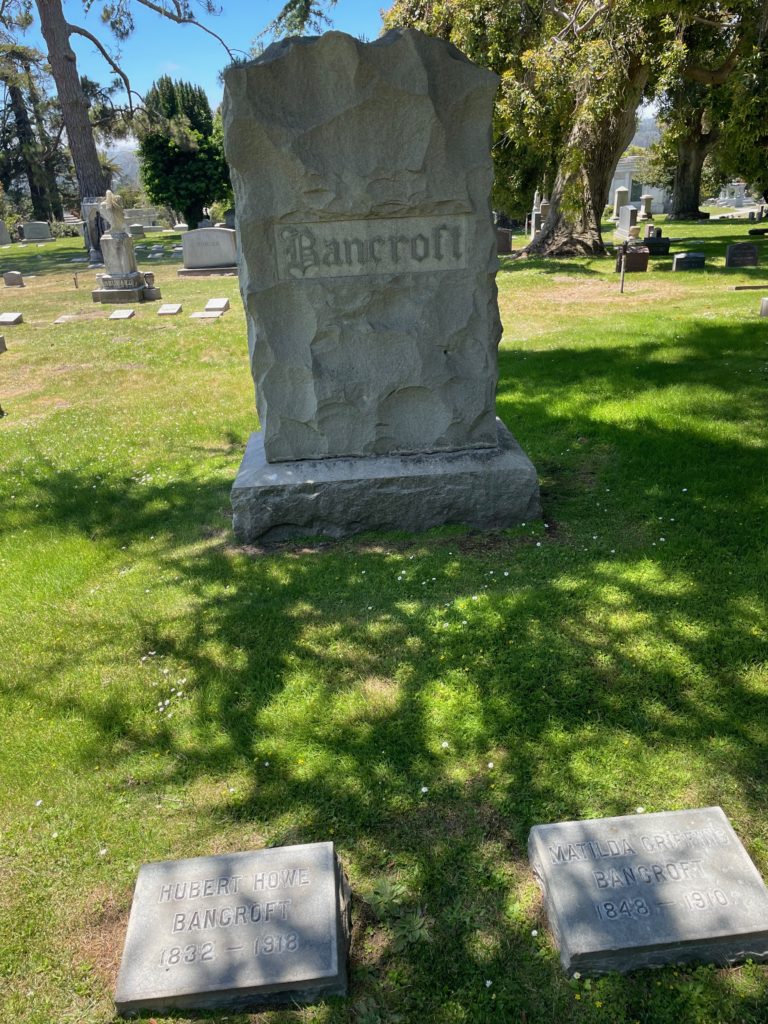Erik Visits an American Grave, Part 1,226
This is the grave of Hubert Howe Bancroft.

Born in 1832 in Granville, Ohio, Bancroft grew up in an abolitionist and religious household that was interested in reform movements generally, as most abolitionists were. He had your standard common school education of the time, got about a year of higher education, then took a job at his brother in law’s bookstore in Buffalo. In 1852, said brother in law sent Bancroft on a long trip to California with a whole lot of ordered books. California needed reading too! They thought that opening a bookstore in San Francisco would be a good business move.
Indeed it was. Bancroft developed the bookstore, built a huge collection for both the store and himself, and then went into publishing. This became a larger family business and his own brothers came into it with him. In 1868, Bancroft gave the business to his brother and went into writing history. He was obsessed with the past, particularly that of Latin America and Native America. Now let’s not beat around the bush here–Bancroft was not somehow ahead of his time on race and provided some sort of histories that 21st century liberals would see as acceptable to their values. He was a Gilded Age man with Gilded Age beliefs. And as we’ve explored time and time again in this series, just because one was an abolitionist very much did not mean said person held twenty-first values on diversity and tolerance.
That said, the man was an intense writer, putting together long series on various topics. He published a five volume series called The Native Races in the mid 1870s, a six volume series on the history of Mexico in the 1880s, a three volume history of Central America during that same decade, and then a huge set of books on the American West. He covered most of the West at some point or another, but is most known for his seven volume history of California that covered the period up to the present, published between 1884 and 1890. Now, he contracted much of this out and took the credit himself. This isn’t exactly uncommon for the time, but this wouldn’t fly in the contemporary historical world. He did take a good bit of criticism for this when news of it came out in the 1890s and some thought it discredited him entirely. In any case, Bancroft was an inveterate self-promoter and he pushed his books very hard, which made him a millionaire.
Regardless on what one thinks of Bancroft’s methods, he did develop an enormous collection of incredibly valuable books. This became the core of the Bancroft Library at the University of California, which bought his collection for $250,000 in 1905. Even today, scholars find Bancroft’s works relatively helpful for the time, particularly his discussion of Native America. You can peruse his gigantic bibliography here.
Bancroft died in 1918, supposedly of peritonitis, though who really knows, at the age of 85.
Hubert Howe Bancroft is buried in Cypress Lawn Memorial Park, Colma, California.
The Bancroft Prize is the top award given in the field of U.S. history. It was founded in 1948 and gives out two or three a year. If you would like this series to visit winners of the Bancroft Prize, you can donate to cover the required expenses here. Alan Nevins, who won in 1948 for Ordeal of the Union, is in Valhalla, New York and Samuel Eliot Morison, who won in 1949 for The Rising Sun in the Pacific, is in Northeast Harbor, Maine. Previous posts in this series are archived here.
It’s Halloween. Which historian are you going as today?


